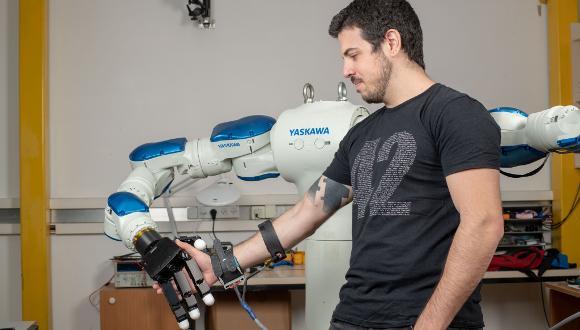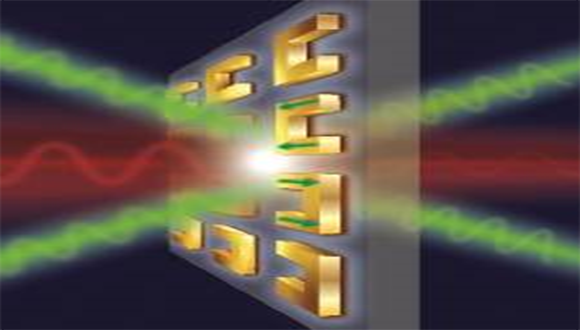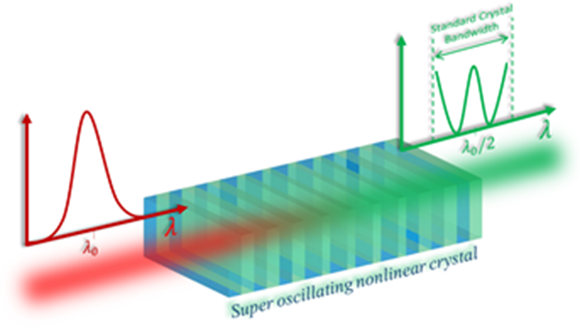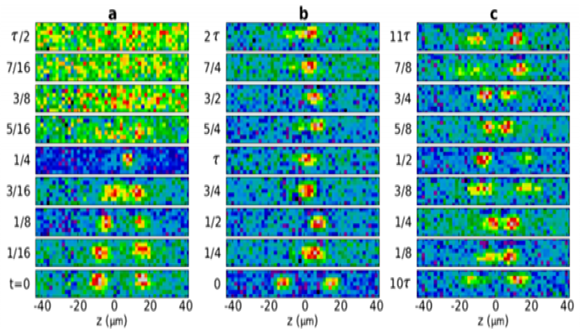Dr. Avishai Sintov has created a wearable device that can detect the movements of the forearm muscles and communicate the intentions of human activities which a robot will sense and reciprocate.


Research
Dr. Avishai Sintov has created a wearable device that can detect the movements of the forearm muscles and communicate the intentions of human activities which a robot will sense and reciprocate.

Human- robot collaboration requires intuitive understanding of human movements. Since our early childhood development, we learn that the different kinds of movements we perform in a certain way, will generate a certain response, more often than not, without any verbal communication. For example, if you offer a cup of coffee to your friend, they will intuitively reach their hand out to take the cup. In fact, by just looking at the cup in your hands, your friend will understand the intention and predict the trajectory of your movements, acting in response.
Publication
The research findings of Dr. Avishai Sintov and graduate student, Nadav Kahanovich, will be published in the The IEEE Robotics & Automation Letters.
Dr. Avishai Sintov is the Head of ROB-TAU lab lab at the Mechanical Engineering at Tel Aviv University. Dr. Sintov and his team of researchers study the prediction of human intentions in non-verbal communication, and aim to “teach” this to robots..
In their article, the researchers showed that a simple and inexpensive wearable device can detect different motions of human forearm muscles. The device contains 15 power sensors that stick to the skin and detect muscles contractions when a person takes various objects and moves a hand. Using their algorithms, the robot receives information about the objects in real time which imply about the intention of the person. The algorithms include a neural network that is trained to read and interpret the information from the device and accurately predict the intention of the interaction in real time.
The ability to predict the intentions of human activities helps the robot plan the movement for efficient and quick assistance. This approach will allow robots to work intuitively without verbal communication and cameras.

Photo: The robot identifies the objects and assists the person
Future Vision
In the future, this technology can assist people with disabilities, for example a wheelchair-mounted robot arm aid to assist with daily activities. It can be also applied in the factories and hospitals. Can you imagine a robot replacing a nurse and assisting a surgeon during medical procedures? We applaud our engineers and students for their fantastic discovery and research which will only enhance our world.
The research is funded by the Israeli Science Foundation.
Loving the problem is the greatest way to invent

Research
From computers, tablets, and smartphones to cars, homes, and public transportation, our world is more digitally connected every day. The technology required to support the exchange of massive quantities of data is critical. That's why scientists and engineers are intent on developing faster computing units capable of supporting much larger amounts of data transfer and data processing.
A new study published in Nature Photonics by Tel Aviv University researchers finds that new optical materials could serve as the nuts and bolts of future ultra-high-speed optical computing units. According to the research, led by Dr. Tal Ellenbogen and conducted by group members Nadav Segal, Shay Keren-Zur, and Netta Hendler, all of the Department of Physical Electronics at TAU'sSchool of Electrical Engineering and TAU's Center for Nanoscience and Nanotechnology, these "nonlinear metamaterials," which possess physical capabilities not found in nature, may be the building blocks that allow major companies like IBM and Intel to move from electronic to optical computing.
At his TAU lab, Dr. Ellenbogen studies the interaction between light and matter at the nanoscale level in order to explore underlying physical mechanisms, which can be used to develop novel optical and electro-optical components.
Read more:
(1) From American Friends of Tel-Aviv University: https://www.aftau.org/news-page-computers--technology?=&storyid4702=2176&ncs4702=3
(2) N. Segal, S. Keren-Zur, N. Hendler, and T. Ellenbogen, "Controlling light with metamaterial-based nonlinear photonic crystals," Nat. Photonics 9, 180–184 (2015).

Research
Nonlinear crystals convert laser light of one wavelength to another. Usually, the nonlinear crystal also converts efficiently other wavelengths that are close enough to the designed wavelength. When the input laser has multiple wavelengths and we are interested only in the specific designed wavelength, this wide response must be narrowed so that the unwanted wavelengths would be filtered out.
However, in order to achieve a narrow conversion response, a long crystal is needed, since the width of the efficiency response (with respect to wavelength) is usually inversely proportional to the crystal's length. Unfortunately, longer crystals are more expensive, consume a larger physical size and moreover, the maximum length of most crystals is limited to a few centimeters at most.
In our research, we show that by appropriate modulation of the nonlinear crystal, the width of the converter can be made as narrow as we like, irrespective of the crystal's length. This is achieved by modulating the nonlinear coefficient with a "super-oscillating" function. Super oscillating functions are band-limited functions that oscillate locally much faster than their highest Fourier component. This work therefore brings the concept of super oscillations to the nonlinear optics regime for the first time. This high resolution nonlinear filter can have applications in optical communication, spectroscopy, quantum information, and more.
Roei Remez and Ady Arie, “Super-narrow frequency converter”, Optica 2, 472-475 (2015), https://www.osapublishing.org/optica/abstract.cfm?uri=optica-2-5-472.

Research
Solitons (solitary waves) are self-trapped wave packets that keep their localized shape in the course of long-distance propagation, due to stable balance between linear spreading out, caused by diffraction and/or group-velocity dispersion, and nonlinear self-focusing. Solitons are fundamental collective-excitation modes in diverse areas, among which two most rapidly developing ones are nonlinear photonics and matter-wave optics (the latter pertains to coherent modes in atomic Bose-Einstein condensates (BEC)). Once the existence of individual solitons has been established, the next issue is collisions between them. Very often, solitons interact elastically, i.e., they pass through one another and emerge from the collision with original shapes, amplitudes, and velocities, the actual result of the collision being a shift of both solitons forward or backward, which seems as a discontinuous jump. This remarkable property is closely related to the fact that, in the simplest but relevant approximation, the soliton dynamics obeys integrable one-dimensional (1D) equations, such as the celebrated nonlinear Schrödinger equation (NLS), which emerges in the same form in a slew of different physical contexts. In particular, the NLS equation is the most fundamental model of both nonlinear photonics and atomic-wave optics. The integrability of the NLS equation implies that its solutions indeed produce elastic collisions between solitons.
The simple 1D approximation holds if the wave field is strongly confined in two transverse directions. Otherwise, in the three-dimensional (3D) setting, the integrability breaks down, the most dramatic consequence of that being a possibility of the collapse, i.e., catastrophic self-compression of the field. Accordingly, soliton-soliton collisions may exhibit complex outcomes, including the onset of collapse, merger of the colliding solitons into a single one, or the quasi-elastic rebound. The BEC in the gas of 7Li atoms makes it possible to realize both quasi-1D and fully 3D regimes, a crucially important experimental technique being the Feshbach resonance (FR), which makes it possible to control the strength of the self-attractive nonlinearity by means of an external magnetic field. While solitons were created in this setup more than 10 years ago [1,2], experimental and theoretical investigation of collisions between them was reported only very recently by Jason Nguyen, Paul Dyke, De Luo, Boris Malomed, and Randall Hulet, "Collisions of matter-wave solitons",
Nature Physics, DOI 10.1038/NPHYS3135, http://www.nature.com/nphys/journal/vaop/ncurrent/full/nphys3135.html (the work was supported by the Binational Science Foundation through grant No. 20110239). Using real-time in-situ imaging, it has been shown that the collision is a complex event, the outcome of which markedly depends on the relative phase between the colliding solitons. Adjusting the strength of the nonlinearity by means of the FR, the collisions have been examined in the proximity of the 1D - 3D crossover. All the above-mentioned outcomes were directly observed in the experiment, and explained theoretically by means of direct simulations and analytical consideration, which treats solitons as quasi-particles: the collapse, merger, and repeated rebounds (in the latter case, the solitons collide repeatedly as they are confined by a weak harmonic-oscillator trapping potential. These outcomes are shown, respectively, in images displayed in panels (a), (b), and (c) of the figure.
This work has quickly drawn attention of the major professional network, PhysicsWorld: http://physicsworld.com/cws/article/news/2014/nov/06/colliding-bose-einstein-condensates-vanish-from-sight.
[1] L. Khaykovich, F. Schreck, G. Ferrari, T. Bourdel, J. Cubizolles, L. D. Carr, Y. Castin, and C. Salomon, Formation of a matter-wave bright soliton, Science 296, 1290-1293 (2002).
[2] K. E. Strecker, G. B. Partridge, A. G. Truscott, and R. G. Hulet, Formation and propagation of matter-wave soliton trains, Nature 417, 150-153 (2002).